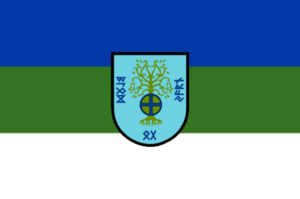Norse diaspora: Difference between revisions
mNo edit summary |
mNo edit summary |
||
| Line 27: | Line 27: | ||
| region8 = {{team flag|Mercury}} | | region8 = {{team flag|Mercury}} | ||
| pop8 = ~ 400,000 | | pop8 = ~ 400,000 | ||
| region9 = {{team flag|Shireroth}} | |||
| pop9 = XXX | |||
| languages = {{Unbulleted list|Norse|Common Tongue}} | | languages = {{Unbulleted list|Norse|Common Tongue}} | ||
| religions = XXXXX | | religions = XXXXX | ||
Revision as of 00:06, 18 November 2024
| Norse folk, Nordfolk | |
 Flag of Normark | |
| Total population | |
|---|---|
| 25,677,329 (1735 AN, estimated) | |
| Regions with significant populations | |
| 142,947 | |
| 2,494,265 | |
| XXXXX | |
| 110,012 | |
| XXXXX | |
| XXXXX | |
| XXXXX | |
| ~ 400,000 | |
| XXX | |
| Languages | |
| |
| Religion | |
| XXXXX | |
| Related ethnic groups | |
| XXXXX | |
Population figures based on 1735 AN census data and estimates. | |
The Norse diaspora refers to the displaced population of ethnic Norse people originating from the former nation of Normark, which existed in northern Keltia until its catastrophic collapse in 1737 AN. Currently numbering approximately 25.6 million people worldwide, the Norse diaspora represents one of the many displaced ethnic populations in modern Micras, with significant communities established across multiple Raspur Pact nations. The diaspora's history spans two major waves: the first occurring in the 1590s with migration to Elwynn, and the second, larger wave following the East Keltian Collapse of 1737 AN, which led to the displacement of nearly the entire Norse population through Operation Northern Light and Operation Haven Shield. Today, Norse communities maintain strong cultural identities while integrated into various host nations, with the largest populations residing in the Benacian Union, Moorland, Natopia, and Nouvelle Alexandrie, where they have established significant cultural, educational, and economic institutions.
History
Elwynn
In the 1590s, Elwynn saw an influx of a few million Norsemen during Elwynn's brief union with Normark (1592–1598). By 1603, Elwynn counted 4,280,428 people belonging to the Norse diaspora. This number grew to just under 5 million by 1632. Later in the 17th century, the Norse diaspora became seen as part of a greater community in Elwynn, also encompassing Hurmudans and Farewellers (also speakers of Norse dialects), and was as such not counted separately from them.
Natopia
- Significant Norse community in Natopia from when it was a Natopian demesne.
- Lindstrom has a prominent Norse quarter from this era.
Following the East Keltian Collapse
Prior to the collapse, Normark had a population of 18,098,321 people by 1727 AN, with a clear Norse ethnic majority of 85% concentrated primarily in its northern regions and major urban centers like Elijah's Rest, which alone housed over 1.7 million inhabitants.
The catastrophic events of 1737 AN triggered Operation Northern Light, an unprecedented Raspur Pact evacuation effort that succeeded in extracting over 275,000 Norse refugees in its initial phase through an extensive network of air and sea routes. The operation involved complex coordination between multiple nations, with seven major processing centers established along Moorland's northern frontier and the deployment of Combined Task Force 77, which included 72 vessels centered around the carrier HMS Imperio del Sol. The evacuation particularly focused on preserving Norse cultural heritage, with systematic relocation of educational institutions, cultural artifacts, and technical expertise.
The subsequent Operation Haven Shield established permanent infrastructure for refugee resettlement across Raspur Pact nations, including 28 dedicated processing centers, 42 permanent housing complexes, and 15 language integration schools. Today, major Norse diaspora communities exist across several nations, with significant populations in the Benacian Union's Governorate of Absentien, Moorland's Burwood region, and Nouvelle Alexandrie's North Lyrica. These communities maintain strong cultural ties through various institutions while contributing significantly to their host nations, particularly in maritime industries, cold-weather technologies, and naval operations.
Geographic Distribution
Culture
Identity and Integration
Institutions
Notable Figures
- Aasmund Vigeland (1581–1620), Elwynnese communist leader, Prætor of the Landsraad
- Daniel Dravot (1559–1657), Elwynnese general
- Frederik Haabye Truls (1620–1691), Prince of Elwynn
- Jack Lewis (1554–1610), Shirerithian nobleman and politician
- Helena Strand (1638–1685), Elwynnese politician
- Kaiser Dominus (1594–1644), Shirerithian kaiser
- Liv Djupvik (1615–1663), Shirerithian noblewoman and ideologue, mother of Kaiser Ayreon IV